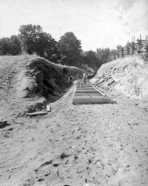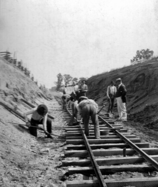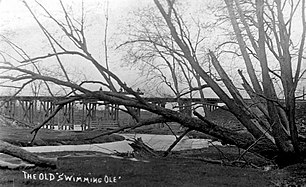Peerless Portland Cement Company Railroad
| Peerless Portland Cement Company Railroad | |||||||||||||||||||||
|---|---|---|---|---|---|---|---|---|---|---|---|---|---|---|---|---|---|---|---|---|---|
|
Steam locomotive No. 2 Daisy
| |||||||||||||||||||||
|
Narrow-gauge railway tracks at the cement factory
| |||||||||||||||||||||
| Route length: | 3.2 km | ||||||||||||||||||||
| Gauge : | 1067 mm ( cape track ) | ||||||||||||||||||||
|
|||||||||||||||||||||
The Peerless Portland Cement Company Railroad (PPCCo.RR) was a 3.2 km long work - narrow-gauge railway with a track width of 3 feet 6 inches (1067 mm) in Union City , Michigan .
location
The train started at the marl pits at Turtle Lake , crossed the St. Joseph River , the Coldwater River and the Mill Race on Trestle bridges and ended at the cement factory in the southeast of the settlement.
history
The oldest company of its kind in Michigan, Peerless Portland Cement was incorporated on August 23, 1896 with capital of $ 250,000. Production started in 1897. The cement plant was completely destroyed by a fire in 1898. It was rebuilt in 1902 for $ 350,000.
In the reconstruction of the originally were hand with coke -fired vertical furnaces replaced by 19 modern circular kilns, each 10.67 m (35 feet) high. These were replaced in 1902 by 9 large, circular kilns 21.34 m (70 feet) in length.
In October 1910, there was a second major fire at the cement plant that presumably killed one person and caused about $ 150,000 in damage. The cement plant was closed in 1927.
business
The cement was made from a mixture of marl and clay with a small admixture of gypsum, which influenced the setting time. The company owned marl and clay pits on more than 1,000 hectares of land. The marl was transported from the marl pits on Turtle Lake to the cement works on the works narrow-gauge railway. The weight of the loaded wagons was determined with a weighbridge before emptying.
The narrow-gauge railway wagons looked like coal dump trucks, but were smaller and made of wood. At a later date, the marl from the Spring Arbor area was delivered with its own mud trains on the standard gauge line of New York Central . The clay pits were about 3 km south of the settlement on the west bank of the Coldwater River. Mainly German immigrants worked there, many of whom spoke little English.
literature
- Tom F. Robinson: Peerless Union City Michigan. March 1903.
- Paul Cross Morrison: Cement Plant Migration in Michigan. In: Economic Geography , Volume 21, No. 1, January 1945, pp. 1-16. Taylor & Francis, Ltd. JSTOR 141380
Individual evidence
- ↑ a b c d Union City Heritage Water Trail: # 6 Narrow Gauge Railway to the Cement Factory. (UCHWT # 6)
- ^ A b Narrow Gauge Railway to the Cement Factory. Union City Heritage Water Trail.
- ^ Ardis Baad: Two other Distastrous Fires Destroyed Industry at 401 Broadway. In: UCHWT # 6.
- ↑ a b Union City 1966 Centennial Book. In: UCHWT # 6.
- ^ David J. Hale: Marl (bog lime) and its application to the manufacture of Portland Cement. In: Geological survey of Michigan Lower Peninsula 1900–1903. Volume 8, Part 3. pp. 35-36.
Coordinates: 42 ° 4 ′ 0 ″ N , 85 ° 7 ′ 42.6 ″ W.





